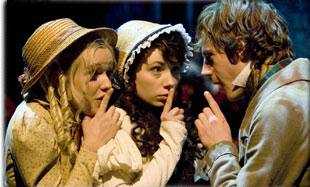 |
Jocelyn Gauthier, Cecile Roslin & Spencer Atkinson, Old Goriot photo Tim Matheson |
Madame Vauquer introduces herself directly to the audience as the owner of this boarding house, “for gentlemen, ladies, and others”, as another projection onto the backdrop informs us. Despite the 19th century setting, each guest introduces him/herself directly to the audience in vernacular English, stating on which floor of the house they stay and how much rent they pay. Rastignac, the ambitious young social climber, includes a lot more detail about himself and his motivations, before being interrupted by the irritable fellow boarders: “this story isn’t about you.” Following this character-labelling, the cast perform an eerie, plodding song, a call for self-reflection: you, the audience, might think that the author is making this story up, until you realise that similar events are happening at your own table at home.
Prologue over, the narrative begins. We are shown snatches of underplayed dialogue, interspersed with Brechtian elements: songs, projections and mime, accompanied by sound effects created in full view of the audience by the musicians. There are direct references to the form of the piece, such as Rastignac’s speedy addition of “intermission” at the end of his final speech of the first half, or the cook exclaiming “the time disappeared, just like a play in the theatre” (perhaps a bit too much of a risk at this point in the second act?). The densely packed narrative of De Balzac’s novel seems to unfold simply in front of us: the lodgers’ curiosity over Old Goriot, the broken, bankrupt vermicelli maker, and his relationship with the two beautiful women who come to visit him; the discovery that these grasping women are in fact his daughters and have treacherously bled him dry of his fortunes; the clumsy attempts at social promotion by Rastignac; the unfortunate and miserable story of each lodger. The smooth storytelling is dotted with bluntly comic moments: the best received being the deadpan delivery of impoverished gentlewoman Mademoiselle Michonneau’s “don’t try to butter me up, bitch”, after overhearing the cook insulting her.
The whole piece is very clearly staged, almost choreographed; each polished scene runs to another seamlessly, each transition creates an aesthetically pleasing, balanced picture. Although we are shown corruption and calculation, there is no overt evil or grime on display in this clean performance. The staging is as methodically planned as the characters’ schemes for social or financial progression. Carefully assigned downstage areas are preserved for whispered conversations such as that between Vautrin, the criminal, who tries to engage Rastignac in a murderous deal that will lead to his social advancement. Wealthier households are presented on the elevated level of the table-top (just in case we haven’t noticed the brightly coloured bejewelled costumes of the richer characters). The viewer is guided through this complex narrative and its themes, each aspect of the novel laid out clearly and signposted with juxtaposition of song, movement and dialogue. Despite the initial call for self-examination, we can comfortably settle into the role of listener and jury.
The Brechtian sparseness in the presentation of greed and exploitation allows the audience to make clinical judgments but there is a sense that we are being presented with the children’s picture book version of an intricate novel. By the end the audience has a clear sense of the pitfalls of being too keen to enter “fashionable Paris”, of the deception and betrayal that social ambition and self-interest can lead to, and of the dangers of being blindly generous in a society that revolves around social status and wealth. We see that Vautrin, the convict, is perhaps the most sympathetic of this assemblage of characters, as he seems to be the only one willing to break free from guileful social play-acting. Having been found out by the police, he redeems himself by forgiving his betrayers, and reminding the gawping onlookers that he has not betrayed anyone. He is perhaps the least hypocritical of this group of down and outs, and his outspoken stand against “organised authority” seems appealing in the context of the rigid structures of this society, and indeed of the performance. We are left with the feeling that this piece might have been more engaging itself, and have encouraged more self-scrutiny in its audience if it had attempted to borrow some of the vigour of Vautrin’s nonconformist philosophy.
Honore de Balzac's Old Goriot, adapted and directed by James Fagan Tait, performers Stephen Aberle, Patti Allen, Mary Black, Anna Hagan, David Mackay, Richard Newman, Gina Stockdale, Alec Willows, Sarah Afful, Spencer Atkinson, Wil Carlos, Jocelyn Gauthier, Max Gilbert, Kevin Kraussler, Jameson Parker, Cecile Roslin, Becky Shrimpton, Kevin Stark, composer Joelysa Pankanea, costumes Mara Gottler, scenography Robert Gardiner, TELUS Studio Theatre, Chan Centre for the Performing Arts, University of British Columbia, Jan 17-26, PuSh International Festival of Performing Arts, Jan 16 - Feb 3
British-born, Eleanor Hadley Kershaw is currently based in Brussels, facilitating communications with IETM - international network for contemporary performing arts/réseau international des arts du spectacle. She has a Foundation Diploma in Art, Media and Design and a BA in English from Cambridge.
© Eleanor Hadley Kershaw; for permission to reproduce apply to [email protected]








 back
back